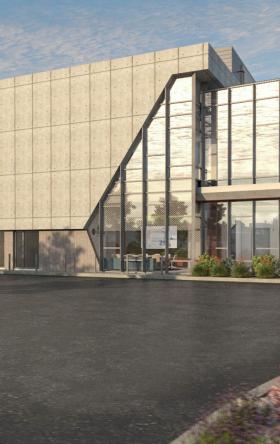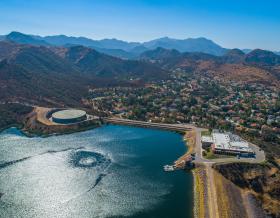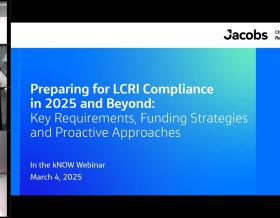A View on the Future of Conveyance and Storage: A Q&A with Dr. Adel Aboujaoude
Global Solutions Director for Conveyance and Storage discusses how Jacobs is helping communities address water scarcity in a changing world

Water is one natural resource we all share – but accessing, protecting and enhancing its supply is more complex than ever.
From aging water infrastructure, regulatory requirements and climate change, our clients face unprecedented challenges as they work to provide critical water services and protect their communities and the environment. In some regions, delivering drinking water is harder than ever, with complex environments and communities needing water at a large scale.
At Jacobs, we’re delivering solutions worldwide to ensure communities have access to safe, reliable water supplies. From the conveyance and storage of treated and raw water to the collection of wastewater, reclaimed water and stormwater, we provide a variety of urban conveyance and storage solutions for projects of all sizes, incorporating sustainability and adapting to changing environmental conditions in every project. Our practitioners, such as Global Solutions Director for Conveyance and Storage Dr. Adel Aboujaoude tailor innovations to best serve each client with the latest technologies and solutions to their toughest water infrastructure, regulatory requirements and climate change hurdles. In this Q&A, we connect with Adel to discuss the trends and opportunities ahead for water conveyance and storage and how we’re tackling water scarcity in a changing world.
Tell us a bit about what a day in the life is like as Jacobs Global Solutions Director for Conveyance & Storage, and what you enjoy most about working in this market?
I’m Jacobs' leader for the water conveyance and storage market, covering building and maintaining dams, conveying water over large distances, treating water to make it potable and storing water safely and securely until it's ready for use by our clients and their communities. In its simplest terms, water conveyance is the transmission from one point to another over large distances, often accomplished using large-diameter pipelines. These projects can be of massive scale, covering hundreds of miles and using up to 80—to 100-inch diameter pipes, which are large enough to drive a car through.
For me, this is a dream job. Working on large and expansive projects with such a wonderful team is what gets me out of bed every day.
What are the biggest challenges in water conveyance today?
Water preservation and reducing what we call non-revenue water or water losses, which is water that was produced but lost before it could reach the customer, is a continued challenge. With the rise of more digital and data solutions, we now have the technological tools available to tackle this problem, including artificial intelligence, digital twins and system optimization, to provide better drinkable water to communities worldwide.
Then there are challenges faced from a changing climate that vary from region to region. For example, in the Middle East, a lot of conveyance and storage work is characterized by a scorching and dry climate, significantly contrasting almost anywhere else in the world. The arid climate is the number one contributor to persistent water scarcity in the region, where there are several areas where drinkable water is not naturally available. In the Middle East, their primary water sources are obtained through desalination, the process of removing dissolved mineral salt from water (usually seawater), producing fresh water for human consumption and agriculture, or transferring clean water over hundreds of miles. In other locations, clients are dealing with issues with sea level rise or combined sewer overflows (CSOs) from wet weather. Every location is different, but in today’s changing world, with the changing climate, every drop of water counts.
Jacobs is known for being a leader in the water market. How do we help clients think differently to respond to future challenges?
Clients come to us because of our service quality. We’re an industry leader and have every possible discipline covered in the water market; if you can think of it, we have it. We have hydrologists, hydrogeologists, climate specialists, water treatment specialists and many more. With outstanding teams and access to a wealth of knowledge across multiple disciplines, our work is state-of-the-art. Most importantly, our teammates take pride in what they deliver for every single project and in every single community. We care about what we do, translating into high-quality products and high efficiency that help our clients tackle whatever issue they’re facing today and think ahead to the issues of the future, whether that’s applying new digital tools or developing more climate-resilient infrastructure.
Can you tell us about projects that you’ve worked on recently? How is Jacobs leading the way in terms of project development and cost savings?
Recently, we have worked on several major, high-budget projects for confidential clients. Over the past three years, my team has worked on many projects worth several billion dollars. Our projects are solution-oriented, designing mega reservoirs. Our team developed a concept during one particular project that cut down construction costs by more than 15%, saving significantly on a multi-billion-dollar project. The concept is simple: instead of soliciting the walls of a concrete reservoir over the full height, we created a recess in the bottom slab that gave us 15% to 20% additional storage at practically no additional cost. Another innovation we introduced for these concrete reservoirs is that we suggested placing the electro-resistivity measurement system for leakage detection. This technology has been known for decades, but we’ve never used it as a permanent leakage detection system for concrete reservoirs before.
What are the biggest opportunities ahead for water conveyance and storage?
The technical population is aging and retiring in the Western Hemisphere, and we need to replace these skilled positions. We need to improve the service level, and again, we can accomplish this through technology by increasing productivity: “Do more with less.”
Another major area that is rapidly expanding is related to energy renewables. We’ve already seen considerable developments in photovoltaic technology (solar panels) and wind energy. However, because these are fluctuating energy sources with periods of ebb and flow, you must store them. One way to accomplish this is through pumped storage hydropower.
We’re in a new era where the development of and innovations in hydropower are starting to take shape and change the market. It’s an exciting time to be involved in and play a role in shaping this future, delivering a more secure and resilient resource supply for tomorrow.
About the interviewee

Dr. Adel AbouJaoude is a highly accomplished civil engineer with more than 30 years of experience in the industry. He has worked on a wide range of projects, from dams to water supply and conveyance systems, and is a recognized expert in developing innovative solutions to complex engineering challenges. Besides water conveyance, Dr. AbouJaoude's areas of expertise include water resources engineering, hydraulic engineering and geotechnical engineering. Trilingual in English, French and Arabic, his work has spanned the globe, from Europe to the Middle East and Central Asia. He’s committed to developing sustainable and resilient engineering solutions that meet the needs of today while providing a foundation for the future. Outside of work, he’s a handyman, who likes painting, sports and spending time gardening or with his family.












































